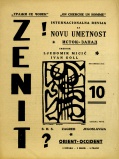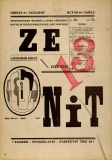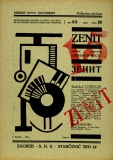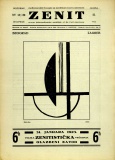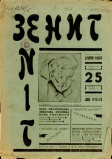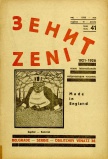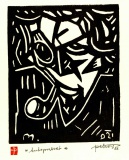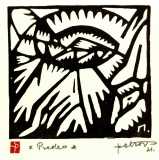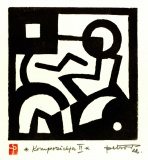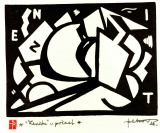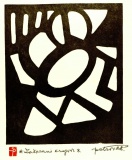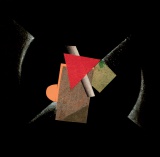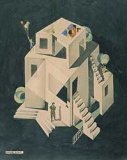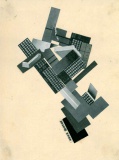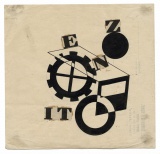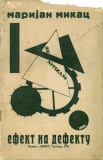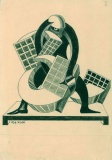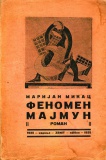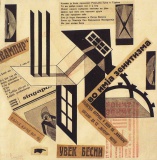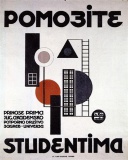Zenit

Zenit: International Review of Arts and Culture was a Yugoslav avant-garde magazine published in 43 numbers in 34 volumes in Zagreb (Feb 1921-May 1923) and Belgrade (Jun 1923-Dec 1926). Its founder, editor and the chief ideologist of the Zenitist aesthetics Ljubomir Micić, a poet and art critic, was the main progenitor of the avant-garde in Croatia and Serbia during the first half of the 1920s.
Through the relentless publication of manifestos and statements in issue after issue of Zenit, Micić gave shape to a specifically Yugoslav avant-garde aesthetics: Zenitism, counterpointing the redemptive force of the Balkanic-Slavic 'barbarogenius' over against the decadence of Western Europe. Over the course of its five years of publication, Zenit accreted successive influences from international Expressionism, Futurism, Dada, and Constructivism to advance its cultural-political goals. Its political orientations were similarly idiosyncratic, eclectic, and fluctuating: a blend of Serbian nationalism, pan-Slavism, pacificism, Bolshevism (though often celebrating the anti-Western Russian character of Lenin and Trotsky rather than their Soviet politics), mystical new-age thought, internationalism, and anarchism. Zenit managed to garner a significant degree of international attention both for its solicitation of work for publication and for its subsidiary activities, such as the First Zenit International Exhibition of New Art held in Belgrade in April 1924. The example of Zenit and the aesthetic ideology of Zenitism inspired other important publications across the region, such as the Hungarian-language journal Út and the Slovenian journal Tank, as well as individual practitioners of avant-garde such as the Dadaist poet Dragan Aleksić and the Slovenian cubo-futurist Srečko Kosovel. [3]
Book edition[edit]
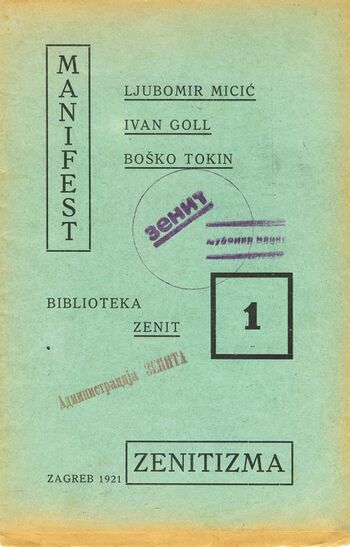
- Ljubomir Micić, Istočni greh. Misterij za bezbožne ljude čiste savesti, Belgrade: Zenit, 1920, 29 pp. (Serbo-Croatian)
- Ljubomir Micić, Ivan Goll, Boško Tokin, Manifest zenitizma, Zagreb: Zenit (Biblioteka Zenit 1), 1921, 15 pp. (Serbo-Croatian)
- Iwan Goll, Paris Brennt, Ein poem nebst einem postkartenalbum, Zagreb: Zenit (Biblioteka Zenit 2), 1921, 16 pp. (German)
- Ljubomir Micić, Kola za spasavanje, Zenitistička barbarogenika u 30 činova, Belgrade and Zagreb: Zenit, 1922. (Serbo-Croatian)
- Branko Ve Poljanski, Tumbe, Belgrade: Zenit, 1926. (Serbo-Croatian)
- Ljubomir Micić, Antievropa, Belgrade: Zenit, 1926. (Serbo-Croatian)
- Metafizika ničega, Belgrade: Zenit, 1926. (Serbo-Croatian)
- Branko Ve Poljanski, Crveni petao, Belgrade: Zenit, 1927. (Serbo-Croatian)
Journal[edit]
The magazine covered poetry, literature, fine arts, theatre, film, architecture, music. Special numbers were dedicated to young Czech artists (Nos. 7 and 8), and the new Russian art (No. 17-18 guest-edited by Ilya Ehrenburg and El Lissitzky).
In its early days, Micić had the editorial cooperation of his brother Branko Ve Poljanski (Branislav Micić), Boško Tokin, and soon, the Expressionist poet Ivan Goll in Paris. Tokin and Goll fell off the masthead by 1922, and subsequently Micić and Poljanski provided the editorial leadership. The journal gathered poets and writers from the cities and cultural centres across Yugoslavia: Zagreb, Belgrade, Ljubljana, Novi Sad, Vinkovci, Sombor, Split and Zemun; it also established cooperation with Yugoslav authors then living in Prague (Dragan Aleksić), Paris (Rastko Petrović, Miloš Crnjanski, Dušan Matić) and Vienna (Zlatko Gorjan). Contributions from Russia and the West were often printed untranslated. Illustrations and reproductions of works by Jo Klek and Mihailo Petrov epitomized Zenitist art and painting.
Zenit was in contact with other avant-garde reviews such as De Stijl, L'Esprit nouveau, Der Sturm and MaHer Oberzic. It had also published books; organized lectures, exhibitions, and soirees.
After the last monthly issue of May 1923 it was published irregularly. Its format and design was changing with every few issues. The last issue (No. 4, Dec 1926) was banned for its putative advocacy of Bolshevism (through the involvement of Russian artists and M. Rasinov's article "Zenitism Through the Prism of Marxism" [Zenitizam kroz prizmu marksizma]); Micić fled across Italy to Paris.
Programmatic texts[edit]
- Micić, "Človek i umetnost" [Man and Art], Zenit 1, Feb 1921, pp 1-2. (Serbo-Croatian)
- Goll, "Zenitistisches Manifest" [Zenitist Manifesto], Zenit 5, Jun 1921, pp 1-2. (German)
- Micić, Goll and Tokin, Manifest Zenitizma [The Manifesto of Zenitism], Zagreb: Biblioteka Zenit, 1921, 16 pp. Printed as the first volume in the periodical's library.
- Micić, "Kategorički imperativ zenitističke pesničke škole" [The Categorical Imperative of the Zenitist Poet School], Zenit 13, Apr 1922, pp 17-19. (Serbo-Croatian)
- Micić, "Шими на гробљу латинске четврти. Зенитистички радио-филм од 17 сочиненија" [Shimmy in the Graveyard at the Latin Quarter], Zenit 12 (Mar 1922), pp 13-15. (Serbian)
- Micić, "Зенитозофиjа или енергетика стваралачког зенитизма" [Zenitosophy, or, the Energy of the Creative Zenitism], Zenit 26-33, Mar-Oct 1924, pp [4-8]. (Serbian)
Issues[edit]
PDFs: 1, 2, 3, 4, 5, 6, 7, 8, 9, 10, 11, 12, 13, 14, 15, 16, 17-18, 19-20, 21, 22, 23, 24, 25, 26-33, 34, 35, 36, 37, 38, 39, 40, 41, 42, 43. All issues in ZIP.
Scans in Digital National Library of Serbia. (Backup at Archive.org).
Scans in World Digital Library.
Reprint[edit]
The monograph Zenit 1921-1926 published by Narodna biblioteka Srbije i Prosvjeta Zagreb in 2008 includes studies about literary and visual culture of Zenit, the complete chronicles of the periodical, biographies of all the contributors, a bibliography, a list of literature on Zenit and zenithism, as well as a valuable webography. The book was printed in full color, on 530 pages, and equipped with illustrations from the magazine, as well as with photographs of contemporary celebrities. Some of the photographs appear for the first time.
The same year another reprint was published by Horetzky in Zagreb.
Zenitist aesthetics[edit]

This section is based on an 2008 essay by Irina Subotić.
Most major European art movements of the early 1920s were reflected in Zenit. Following the initial clear orientation towards expressionism, the focus being on young, unrecognised artists, Zenitism practiced the ambivalent interpretation of dada, futurism and accepted the new wave of cubism. In its mature phase, Zenit introduced new, abstract art of varying orientation: from the activism and lyrical abstraction of Kandinsky, to various geometrical tendencies and constructivist movements – purism, neoplasticism, Bauhaus, especially constructivism, productionism, and functionalism.
The first issues of Zenit - both the articles and reproductions – were characterised by expressionist individualism and artists who were critically disposed towards the bourgeois society of the early 20th century (Vilko Gecan, Egon Schiele, Rolf Henkl, Carry Hauser, Franz Bronstert, Jacoba van Heemskerk). But even though it was dominant, expressionism was not the only movement present in the initial phase of Zenit: very early on, cubism, futurism and dada featured on its pages. In his article "Pozorište u vazduhu" [Theatre in the Air], Boško Tokin pointed out the multidisciplinary experiments of the Italian futurist Fedele Azari, who looked at the airplane as an “extension of the body”, with dynamism and motion, pantomime, acrobatics, set design and urban spectacles, unconventional sounds and an anti-painterly way of using colour. Introducing the public to contemporary Paris exhibitions, Rastko Petrović presented the absence of sentimentalism and any narrativity in diverse variants of the then influential cubism, singling out the works of Ossipe Zadkine, Alexander Archipenko and Jacques Lipchitz – sculptors with whom Micić and Poljanski would immediately establish personal contacts. The French theoretician Florent Fels explained cubism as “a powerful means of creating a new aesthetics” and “a synthesis of space”, which Zenit underscored by printing reproductions of works by artists of various cubist orientations – A. Gleizes, L. Survage, R. Delaunay, and later P. Picasso, V. Foretić-Vis, O. Zadkine, J. Czáky and especially A. Archipenko. A poeticised variant of cubism was also advocated in Zenit by young Czech authors – poets, painters and architects gathered around Karel Teige and leftist revues - J. Havlíček, A. Wachsman, L. Süss, B. Piskač, A. Hoffmeister. Dada was given an important place in Zenit – both in the form of favourable presentation (the periodical published reproductions of works of Berlin dadaists George Grosz and Rodolf Schlichter) and with critical and ironic commentary. The presence of dada was the result of the socialising of Poljanski and Dragan Aleksić in Prague, the latter’s texts on Schwitters and on Tatlin, the meeting with Berlin dadaists, joint actions, matinees and evening events staged with collaborators in many Yugoslav cities.
Micić expressed his programmatic principle concerning the changed nature of art, that is, nonrepresentional, abstract painting, in his reviews of exhibitions and in the theoretical article "Contemporary New and Surmised Painting", in which he abandoned the ideas of expressionism and argued in favour of art based on the principle of non-mimeticism, freedom of creation, the secondary place of form, the precedence of “the spiritual – abstract – absolute”, relying on the examples of Kandinsky, Chagall and Archipenko.
Zenit affirmed the work of Hungarian leftist activists, led by Lajos Kassák. This meant approaching geometrical abstraction and constructivist tendencies as a collective act. At the same time, in the course of the year 1922, Russian avant-garde assumed concrete and applied forms in Zenit: the periodical reproduced Tatlin’s Draft of a Monument to the Third International, an utopian and visionary work of new technology and ideology, whereas Rodchenko’s kiosk became a meeting point of all zenitists in Micić’s zenitist radio-film "Шими на гробљу латинске четврти. Зенитистички радио-филм од 17 сочиненија" [Shimmy in the Graveyard at the Latin Quarter]. Owing to intensive cooperation with Ilya Ehrenburg and El Lissitzky, editors of the Veshch periodical and the most prominent representatives of the Russian Berlin, Zenit followed the phenomena of topical interest in Russia – public celebrations and urban spectacles, the adorning of ships, trains, streetcars, the squares and the streets of Moscow and St Petersburg, which strengthened Micić’s view that exhibitions had to have a social role, that is to say, they ought to be intended for the broadest circles of viewers. The peak of this editorial policy is The Russian Issue (no. 17-18), dedicated in its entirety to Russian avant-garde in all artistic disciplines. The issue was edited by Ilya Ehrenburg and El Lissitzky (the latter is the author of the cover design for this issue of Zenit, in the form of his project of the new – PROUN).
There were echoes of Russian avant-garde in the Zenit criticism as well: Ve Poljanski wrote a text entitled "Kroz rusku izložbu u Berlinu" (Through the Russian Exhibition in Berlin), which A.B. Nakov considered to be, “on the basis on any criteria, among the most inspired and profound reviews of this exhibition”. Poljanski did not hide his elation over the revolution carried out by Russian avant-garde artists.
A certain balance in establishing relations between the East and the West was achieved in Zenit by following the concept of neoplasticism in Theo van Doesburg’s text "Volja ka stilu“ [Will to Style], which advocates the ideas of collectivism, logic, synthesis, energy, truth and purity. On the other hand, the apologia of the social influence of art and architecture – which became dominant during a later phase of Zenitism – was contributed to by Jozef Peeters’s "Катихизис пријатеља уметности" [A Catechesis of Friends of Art]: in the propaedeutic form of ten commandments, the text points out the idea of a social project in which geometrical abstraction would become a part of modern life. For a practical application of this concept, Zenit published works of objective abstraction – by Peeters, L. Lozowick, H. Behrens-Hangeler, and a joint collage by Micić and Jo Klek entitled In the Name of Zenitism. The functionalisation of such ideas had already been promoted on the pages of Zenit through the works of A.-P. Gallien, K. Teige, L. Kassák, L. Moholy-Nagy, El Lissitzky, A. Rodchenko, K. Malevich, M. S. Petrov, Jo Klek. Fitting in with the programme of the Balkanisation of Europe, in his text “Anti-social Art Should be Destroyed” Micić argued in favour of the internationalisation of all cultural values, underlined the importance of folk skills and gave preference to craft schools over museums – which he described as tombs and “the pantheons of idleness”. During a later phase, the periodical increasingly reprinted political caricatures as a substitute for classical fine arts works. They provided ironic comments at the expense of capitalism, the bourgeois society, the League of Nations, functioning in the same manner as Micić’s systematically fought battle with bureaucracy, the state administration, the police, the media and the like. Moreover, it was a declaration of war to the entire imperialist-capitalist, non-democratic world, made in a utopian hope that it was possible to build a new, different and better world.
In absolute discontinuity with the Serbian graphic art of the time, Mihailo S. Petrov (“a new asset of ours”, as Zenit wrote) marked the first phase of Zenitism (1921) by his black-and-white linocuts programmatically provided for the pages of Zenit (numbers 6-13). Petrov, who later contributed to other avant-garde periodicals as well (Dada-Tank, Út), represents an example of a dual allegiance, to both expressionist and abstract art, close to Kandinsky. His linocuts, made in symbiosis with poetry, were especially valuable as such, being the first examples in Serbian and Yugoslav art.
In the mature phase of Zenit (1923-1925), the most memorable mark of zenitist art was left by Josip Seissel (known in Zenitism under the pseudonyms Jo and Josif Klek). At international exhibitions in the 1920s (held in Belgrade, Bucharest, Bielefeld, Moscow), he represented Zenit, which published his collages, photomontages, architectural drafts, drawings, watercolours, temperas, sketches for theatre costumes and a curtain, advertisements, ex-libris etc. He was responsible for the graphic design and layout of some of Zenit’s editions (Effect on Defect and The Monkey Phenomenon by Marijan Mikac), and he was also the author of the Zenit exhibition poster. His abstract and multidisciplinary work was used by Micić to identify PAFAMA (Papier-Farben-Malerei, the Serbian version of which was ARBOS – (h)ARtija-BOja-Slika [paper-colour-picture]) as an authentic phenomenon of zenitist art. His work is characterised by narrativity, humour and irony of dadaist provenance. Relying on the constructivist principles of the valuation of materials and exploration of space, Klek became involved in non-representational art, quite exceptional in Croatian and Yugoslav art of the early 1920s.
Works[edit]
Mihailo Petrov[edit]
Autoportret [Self-Portrait], 1921, printed 1971. Linocut. Printed in Zenit 6 (1921).
Današnji zvuk [The Sound of Today], 1921. Linocut. Printed in Zenit 6 (1921).
Predeo [Landscape], 1921, printed 1971. Linocut. Printed in Zenit 8 (1921).
Ritam [Rhythm], 1921, printed 1971. Linocut. Printed in Zenit 10 (1921).
Zenit [Zenith], 1922, printed 1971. Linocut. Printed in Zenit 13 (1922).
Jo Klek (Josip Seissel)[edit]
Pafama, 1922. Collage; pastel/paper. 17 x 17 cm. MSU Zagreb. [1]
Designs for Le Théâtre zénitiste, 1923. Centre: stage curtain; left and right: costumes. Printed in Zenit 24 (1923).
Advertising Kiosk, 1923. Watercolor. Printed in Zenit 34 (1924).
Sketch for Zeniteum I, 1924. Printed in Zenit 35 (1924).
with Ljubomir Micic, Во имја зенитизма, 1924. Collage. Printed in Zenit 26-33 (1924).
Anthology[edit]
- Zenithism (1921–1927): A Yugoslav Avant-Garde Anthology, eds. Aleksandar Bošković and Steven Teref, Brookline, MA: Academic Studies Press, 2023, 694 pp. Publisher.
Literature[edit]
- Irina Subotić, "'Zenit' and 'Zenitism'", trans. Ann Vasić, The Journal of Decorative and Propaganda Arts 17: "Yugoslavia" (Autumn 1990), pp 14-25. (English)
- Irina Subotić, "The avant-garde visionary and utopian model proposed by Ljubomir Micic and his journal Zenit", Balkan Studies 3-4 (1996), pp 54-57. (English)
- Dragan Kujundzic, Jasna Jovanov, "Yougo-Dada", in Gerald Janecek and Toshiharu Omuka (eds.), The Eastern Dada Orbit. Crisis and the Arts. The History of Dada 4, New York, 1998, 58ff. (English)
- Irina Subotić, "Istorijske avangarde: dadaizam - zenitizam - nadrealizam", in Od Avangarde do Arkadije, Belgrade: Clio, 2000. (Serbo-Croatian)
- Darko Šimičić, "From Zenit to Mental Space: Avant-garde, Neo-avant-garde, and Post-avant-garde Magazines and Books in Yugoslavia, 1921-1987", in Impossible Histories: Historical Avant-gardes, Neo-avant-gardes, and Post-avant-gardes in Yugoslavia, 1918-1991, eds. Dubravka Djurić and Miško Šuvaković, MIT Press, 2003, pp 294-331. (English)
- Milan Grba, "Belgrade", in Stephen Bury (ed.), Breaking the Rules. The Printed Face of the European Avant Garde 1900-1937, London: The British Library, 2007, pp 74-76. (English)
- Vidosava Golubović, Irina Subotić, Zenit 1921-1926, Belgrade: National Library of Serbia, and Zagreb: SKD Prosvjeta, 2008, 516 pp, PDF. (Serbian),(English)
- Vidosava Golubović, "The Zenit Periodical (1921-1926)", pp 469ff. (English)
- Irina Subotić, "The Visual Culture of the Zenit Periodical and Its Publications", pp 477ff. (English)
- Irina Subotić, "Zenitism / Futurism: Similarities and Differences", in International Yearbook of Futurism Studies, ed. Günter Berghaus, De Gruyter, 2011, pp 201-230. (English)
- Darko Šimičić, "Strategije u borbi za novu umjetnost. Zenitizam i dada u srednjoeuropskom kontekstu", in Moderna umjetnost u Hrvatskoj, 1898.-1975., Zagreb: Institut za povijest umjetnosti, 2012, pp 40-65. (Croatian)
- Jasmina Čubrilo, "Yugoslav avant-garde review Zenit (1921-1926) and its links with Berlin", Centropa 12:3 (Sep 2012). (English)
- Pavle Levi, Cinema by Other Means, Oxford University Press, 2012, pp 11-14 & 49-52. (English)
- Laurel Seely Voloder, Tyrus Miller, "Avant-Garde Periodicals in the Yugoslavian Crucible", in The Oxford Critical and Cultural History of Modernist Magazines, vol. 3 (Europe, 1880-1940), New York: Oxford University Press, 2013, pp 1099-1127. (English)
- Sezgin Boynik, "Marxist-Leninist Roots of Zenitism: On Historical Avant-Garde Corrections Introduced by Karpo Godina's film Splav Meduze", in On the Cinema of Karpo Godina: or a book in 71383 words, ed. Filmkollektiv Frankfurt, Frankfurt: Filmkollektiv, 2013, pp 133-139. (English)
- Sezgin Bojnik, "Marksističko-lenjinistički koreni zenitizma: o istorijskim korekcijama avangarde koje je uveo film Splav meduze Karpa Godine", in En garde 20/21, eds. Branislav Dimitrijević, Maria Glišić, and Aleksandra Sekulić, Belgrade: Heinrich Böll Stiftung & Centar za kulturnu dekontaminaciju, 2016, pp 68-76. (Serbian)
- Marijeta Bozovic, "Zenit Rising: Return to a Balkan Avant-Garde", in After Yugoslavia: The Cultural Spaces of a Vanished Land, ed. Radmila Gorup, Stanford University Press, 2013, pp 135-146. (English)
- Дарина Дончева, "Гео Милев и Зенит", n.d. (Bulgarian)
- Zbornik Seminara za studije moderne umetnosti Filozofskog fakulteta Univerziteta u Beogradu / The Journal of Modern Art History Department, Faculty of Philosophy, University of Belgrade 12, Belgrade, 2016. (Serbian),(English)
- Iva Glisic, Tijana Vujosevic, "I am Barbarogenius: Yugoslav Zenitism of the 1920s and the Limits of Performativity", The Slavic and East European Journal 60:4, 2016, pp 718-743. [4] (English)
- Ivana Janković, "Upravo se navršava 100 godina časopisa koji je bio ishodište hrvatske avangardne umjetnosti", Jutarnji list, 11 Feb 2021. (Croatian)
- Božidar Zečević, "Зенитистичка филмска монтажа пре филма или Мицићево откриће водећег принципа авангарде", Knjizevna istorija 53:175, 2021. (Serbian)
- Bibliography
- Literatura o Zenitu i zenitizmu [Литературу о Зениту и зенитизму], in Golubović, Subotić, Zenit 1921-1926, Belgrade, 2008, pp 421-463. (1397 entries, 1921-2007).
Film[edit]
- Splav meduze, dir. Karpo Acimovic-Godina, 1980.
See also[edit]
- First Zenit International Exhibition of New Art
- Ljubomir Micić
- Mihailo Petrov, Josip Seissel
- Croatia#Avant-garde, Serbia#Avant-garde
Links[edit]
- Zenit magazine at Monoskop Log.
- Zenit in DADA & Modernist Magazines
- Zenit in Virtual Museum of Avant-Garde Art, Marinko Sudac Collection, Varazdin, Croatia.
- Selection of writings from Zenit
- Zenit at Wikipedia
- Zenitism at Wikipedia
| Avant-garde and modernist magazines | ||
|---|---|---|
|
Poesia (1905-09, 1920), Der Sturm (1910-32), Blast (1914-15), The Egoist (1914-19), The Little Review (1914-29), 291 (1915-16), MA (1916-25), De Stijl (1917-20, 1921-32), Dada (1917-21), Noi (1917-25), 391 (1917-24), Zenit (1921-26), Broom (1921-24), Veshch/Gegenstand/Objet (1922), Die Form (1922, 1925-35), Contimporanul (1922-32), Secession (1922-24), Klaxon (1922-23), Merz (1923-32), LEF (1923-25), G (1923-26), Irradiador (1923), Sovremennaya architektura (1926-30), Novyi LEF (1927-29), ReD (1927-31), Close Up (1927-33), transition (1927-38). | ||
| Full list | ||
|---|---|---|
|
Entretiens politiques et littéraires (1890-93), Moderní revue (1894-1925), Volné směry (1897-1948), Mir iskusstva (1898-1904), Vesy (1904-09), Poesia (1905-09, 1920), Zolotoe runo (1906-10), The Mask (1908-29), Apollon (1909-17), Ukraïnska khata (1909-14), Der Sturm (1910-32), Thalia (1910-13), Rhythm (1911-13), Trudy i dni (1912), Simbolul (1912), The Glebe (1913-14), Ocharovannyi strannik (1913-16), Revolution (1913), Blast (1914-15), The Little Review (1914-29), Futuristy (1914), Zeit-Echo (1914-17), The Egoist (1914-19), L'Élan (1915-16), 291 (1915-16), Orpheu (1915), La Balza futurista (1915), MA (1916-25), SIC (1916-19), flamman (1916-21), The Blindman (1917), Nord-Sud (1917-18), De Stijl (1917-20, 1921-32), Dada (1917-21), Klingen (1917-20, 1942), Noi (1917-25), 391 (1917-24), Modernisme et compréhension (1917), Anarkhiia (1917-18), Iskusstvo kommuny (1918-19), Formiści (1919-21), S4N (1919-25), La Cité (1919-35), Aujourd'hui (1919), Exlex (1919-20), L'Esprit nouveau (1920-25), Orfeus (1920-21), Action (1920-22), Proverbe (1920-22), Ça ira (1920-23), Zenit (1921-26), Kinofon (1921-22), Het Overzicht (1921-25), Jednodńuwka futurystuw (1921), Nowa sztuka (1921-22), Broom (1921-24), Život (1921-48), Creación (1921-24), Jar-Ptitza (1921-26), New York Dada (1921), Aventure (1921-22), Spolokhi (1921-23), Gargoyle (1921-22), Veshch/Gegenstand/Objet (1922), Kino-fot (1922-23), Le Coeur à barbe (1922), Die Form (1922, 1925-35), 7 Arts (1922-28), Manomètre (1922-28), Ultra (1922), Út (1922-25), Dada-Jok (1922), Dada Tank (1922), Dada Jazz (1922), Mécano (1922-23), Contimporanul (1922-32), Zwrotnica (1922-23, 1926-27), Secession (1922-24), Stavba (1922-38), Gostinitsa dlya puteshestvuyuschih v prekrasnom (1922-24), Putevi (1922-24), Klaxon (1922-23), Akasztott Ember (1922-23), MSS (1922-23), Perevoz Dada (1922-49), Egység (1922-24), L'Architecture vivante (1923-33), Merz (1923-32), LEF (1923-25), G (1923-26), The Next Call (1923-26), Russkoye iskusstvo (1923), Disk (1923-25), Irradiador (1923), Surréalisme (1924), Almanach Nowej Sztuki (1924-25), La Révolution surréaliste (1924-29), Blok (1924-26), Pásmo (1924-26), DAV (1924-37), Bulletin de l'Effort moderne (1924-27), ABC (1924-28), CAP (1924-28), Athena (1924-25), Punct (1924-25), 75HP (1924), Le Tour de Babel (1925), Periszkop (1925-26), Integral (1925-28), Praesens (1926, 1930), Sovremennaya architektura (1926-30), bauhaus (1926-31), Das neue Frankfurt (1926-31), L'Art cinématographique (1926-31), Dokumentum (1926-27), Kritisk Revy (1926-28), Novyi LEF (1927-29), i 10 (1927-29), Nova generatsiia (1927-30), ReD (1927-31), Dźwignia (1927-28), Tank (1927-28), Close Up (1927-33), Horizont (1927-32), transition (1927-38), Discontinuité (1928), Munka (1928-39), Quosego (1928-29), Urmuz (1928), Unu (1928-32), Revista de Antropofagia (1928-29), 50 u Evropi (1928-29), Documents (1929-30), L'Art Contemporain - Sztuka Współczesna (1929-30), Adam (1929-40), Art concret (1930), Zvěrokruh (1930), Alge (1930-31), Le Surréalisme au service de la révolution (1930-33), Levá fronta (1930-33), Kvart (1930-37, 1945-49), Nová Bratislava (1931-32), Linja (1931-33), Spektrum (1931-33), Nadrealizam danas i ovde (1931-32), Ulise (1932-33), Die neue Stadt (1932-33), Mouvement (1933), PLAN (1933-36), Karavan (1934-35), Ekran (1934), Axis (1935-37), Acéphale (1936-39), Telehor (1936), aka (1937-38), Plastique (1937-39), Plus (1938-39), Les Réverbères (1938-39). | ||


